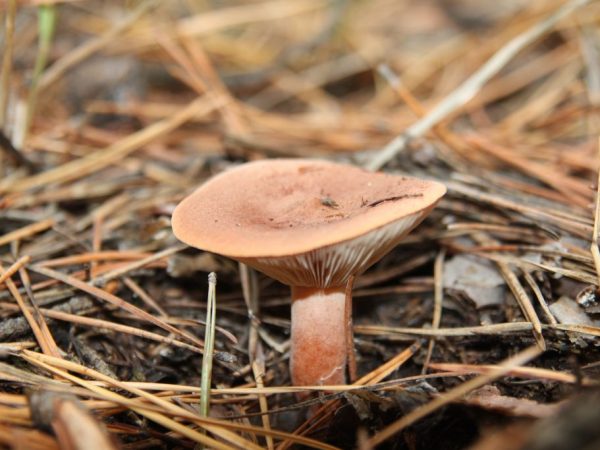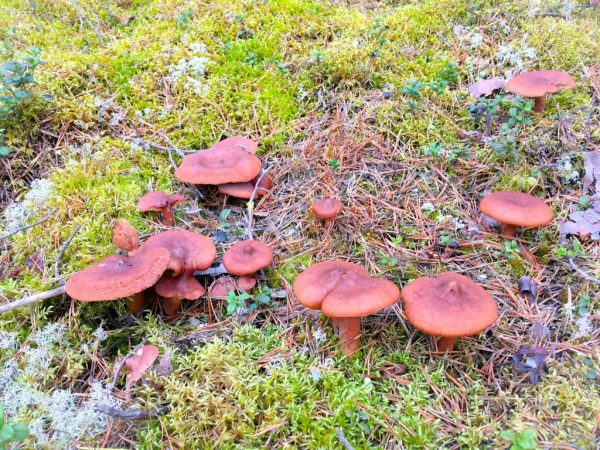Description of false waves
Volnushka mushrooms are popular among mushroom pickers as one of the best for pickling and pickling. They belong to the genus Mlechnik; when broken at the site of damage, they emit juice of a burning and bitter taste. There are several types of edible waves. However, there is also a false wave mushroom, which cannot be eaten.

Description of false waves
Description and types
Volnushka is the second of the 4 categories of edible mushrooms. There are 2 types of them, which are considered the most popular and have good taste:
- The flower is pink or Volzhanka: it is larger in comparison with other mushrooms. Her cap reaches 15 cm in diameter and has a pleasant pinkish color, as well as a pattern in the form of rings. In young mushrooms, the shape of the cap is slightly convex; as it grows, it becomes funnel-shaped, with curved edges that have a small peculiar edge, somewhat reminiscent of cotton wool. The pulp is white and dense, practically does not break during long-term transportation. The leg is also pink, hollow inside.
- The whirlwind is white or white woman: the sizes are slightly smaller than pink. The cap reaches 10 cm in diameter, white with a funnel in the center, and also has a fringe. The leg is the same color as the hat. In a young mushroom, it is solid inside, then it becomes hollow.
White and pink waves grow where there are many birches, forming mycorrhiza with the roots of these trees. They love lit places, so they are more often found on the edges or small forest clearings.
These mushrooms prefer warm, humid weather. A feature of growth is group growth, forming a circle, the so-called "witch's rings". They are explained by the circular placement and growth along the entire perimeter of the mycelium underground.
Yellow marsh and gray waves prefer more humid, marshy places.
The collection season depends on the weather conditions. Early warmth and high humidity contribute to their collection from June. Usually the period of mass gathering is from August to October.
False waves
Inexperienced mushroom pickers in appearance confuse pink fluff with saffron milk cap. But the habitat of the latter is coniferous forests, when damaged, it secretes juice of a bright red-orange color, its cap is smooth, without signs of hairiness.

Some species are unfit for consumption
When collecting, you need to pay attention to all the details of the external structure of the mushroom.
Irina Selyutina (Biologist):
The wave can only be confused with other representatives of the Mlechnik genus. Those species that are owners of pinkish hats in color, novice mushroom pickers can take for a pink wave. In order not to suffer from ignorance, pay attention to the size (usually the false waves are smaller than the true ones and the pubescence of the edge - they may not be so "hairy" or even be without it. This is important. Despite the differences - conditionally edible twins of the waves are not dangerous for a person after soaking and boiling.
Poisonous twins are absent in the little waves, but there are 2 groups of such twins: conditionally edible false waves and inedible ones. Conditionally edibles include:
- The flower is yellow or wave: this mushroom belongs to the same genus Mlechnik, but its exact name is yellow milk mushroom. This name - "wave", most likely the mushroom received for the shape of the edge of the cap. The color of the cap and legs is yellowish. It is larger than the species described. There are specimens up to 25 cm in diameter. It is characterized by the following features: pubescent and downward-curled edges of the caps.
- Marsh wolf, or sluggish milkman, or faded milkman: it has a small cap, slightly depressed, of a grayish-lilac color, with a smooth and sticky skin. The pulp is thin and brittle. The juice released during damage becomes greenish over time. The pubescence is absent along the edge of the cap.
- The wave is gray or gray milky (popularly - serushka): the cap of this species is light gray, and sometimes gray-purple in color with circles of a darker shade towards the center, thin, with a smooth surface. The stem is slightly lighter, dense and long, with grooves along its entire length.
The use of these mushrooms is allowed only in salted form and subject to long-term pretreatment.
Inedible false waves include the following species from the genus Mlechnik:
- Miller sticky: the cap is grayish-green in color, darkening towards the center, interspersed with dark spots, as well as a lighter sticky leg. The pulp is white, the taste is burning and bitter, with a weak odor. The juice released during the break is thick and sticky, over time it acquires a green-olive tint.
- Thorny milky: the color of the cap is from pink to burgundy brown, with small red scales. The pulp is dull, light in color, there is practically no smell, the taste is extremely pungent. When broken, a thick milky sap is released, which slowly changes its color from white to dark green.
- Liver Miller: a cap, smooth in the form of a funnel, is characterized by a brown color with an olive tint. The flesh of this species is brittle, light brown and extremely pungent in taste. White milky juice turns yellow on contact with air.
Differences between a real mushroom and a false one
Differences between edible real waves and inedible false ones:
- the obligatory presence of the edge along the edge of the mushroom;
- pronounced pink color of the cap with rings on the surface;
- curved edge shape;
- white color of the juice when broken and a characteristic pungent odor.
You should be careful when collecting these mushrooms, carefully review them, rejecting unsuitable and questionable, but at the same time similar to edible specimens. Also, the rules of correct processing before use should not be neglected.
Conclusion
The "quiet hunt" for waves rarely disappoints the mushroom picker. Chances are good to fill the basket without “winding” kilometers through the forest. Correctly prepared salted and pickled waves will bring true delight even to the most sophisticated connoisseur. The main thing is to be able to distinguish them from false representatives.



